#Jewish embroidery
Explore tagged Tumblr posts
Text
Ok so i am late by like a month, i have been busy and STILL didn't finish my native jewish miku but fuck it here's indigenous, native israeli miku with a little of my touch and a small analysis:
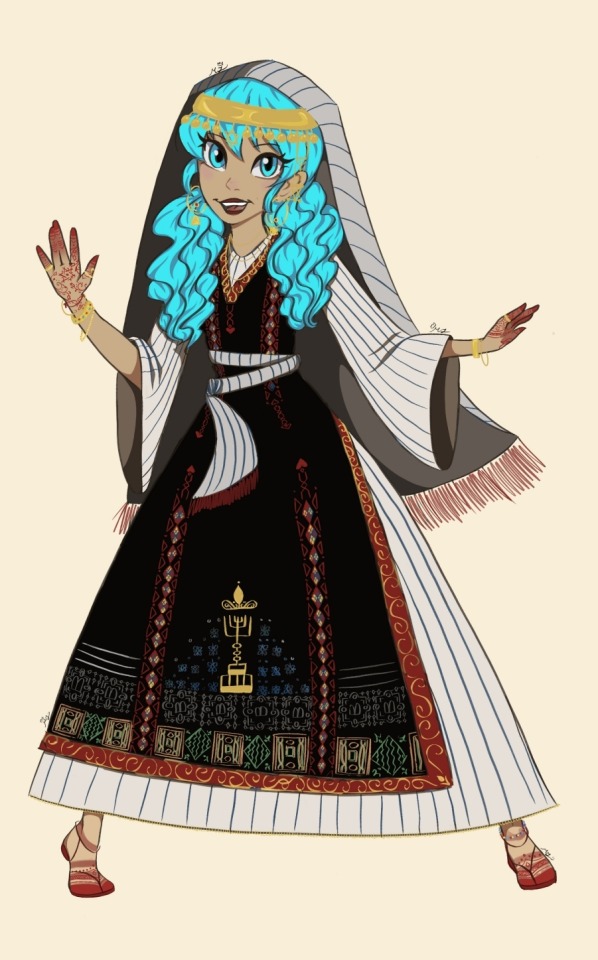
The clothes:
The dress is double layered and based on biblical description i saw of the clothes ancient jews wore i added yellow hoops at the end of the dress to represent the color of our oppression- yellow belts under the muslim rule and yellow stars in the holocaust
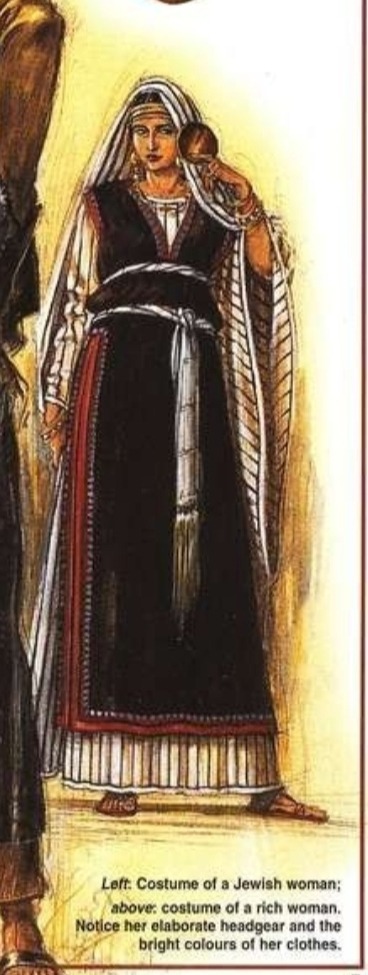
The embroidery:
The Rikma(embroidery) is a personal project i am working on for the past 3 months. The embroidery that WAS practiced on the land eventually was allowed only to muslims and arabs, jews in ottoman syria/palestine were so oppressed and poor they didn't have access to threads and around 1800's some rabbis discoraged jews being involved in arab activity, not only that the jews has completely disconnected themselves from most of the arab culture after the spread of zionism to the land as a form of building their own identity. And if there were jews involved in embroidery it is unknown bc all the photos i see are labeled as "palestinian woman" with no explanation if it is a christian, muslim or jewish.
My project consists of making patterns and motifs based on jewish history, symbols, traditions, land etc and i try to make it original, unique and as diverse from the tatreez as possible to avoid conflict. If any of you want i can explain in a different analysis on what each pattern represents.
The jewelry:
I genuinely suck at drawing gold and jewelry and tried my best to adorn her with as much jewelry as i can. The side piece(that can barely be seen) is also a pattern i came up with, i call it "amulet"
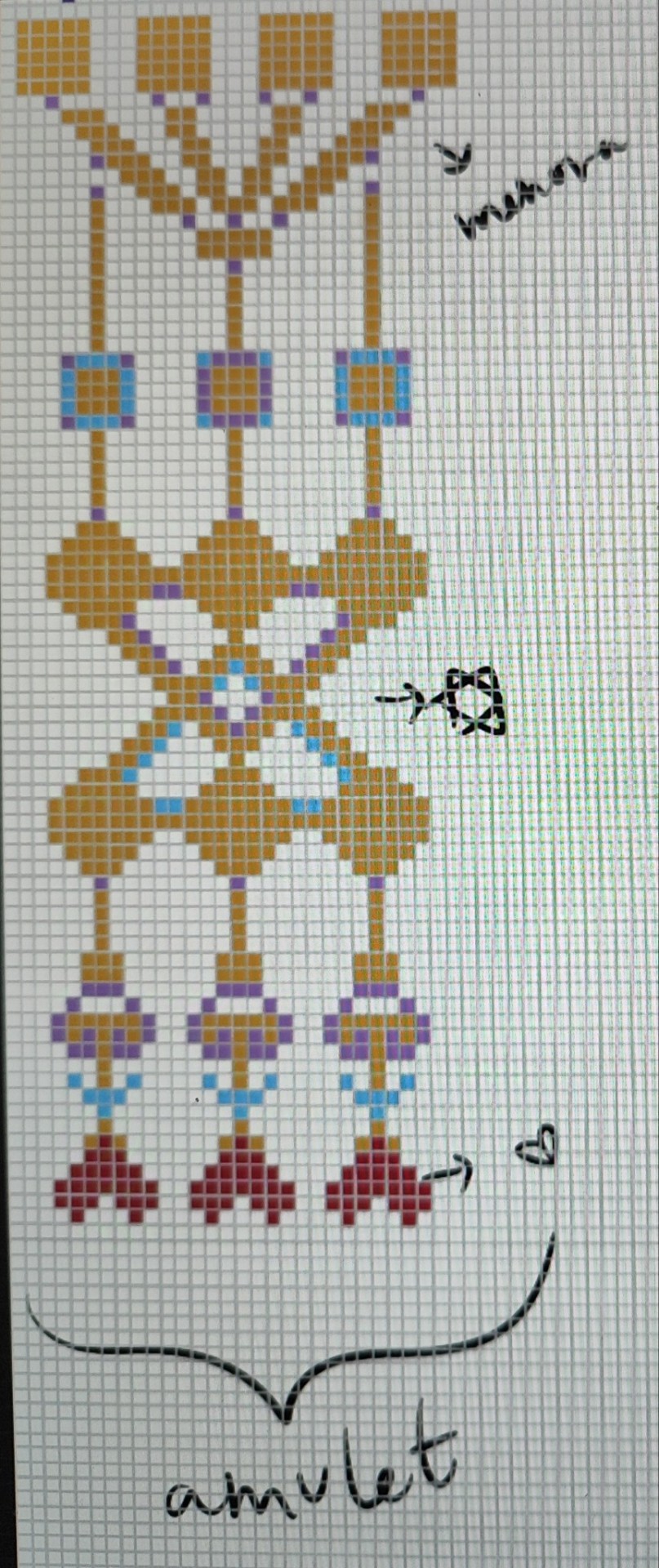
(ps. I forgot to make her a normal necklace, wanted to make it with a hamsa)
Henna:
Henna is still practiced by jews, mainly sefardic and mizrahi jews + ashkenazi jews who grow up and participate in mizrahi culture. The henna on the hands is based on patterns i saw some jewish artists made (on google unfortunately it didn't have names) which has the star of david on it and on the legs i made a mix of bukharan and yemeni jewish henna.
So here it is. A native, indigenous jewish/judean/israeli(te) miku. I tried my best✨
#miku hatsune#hatsune miku#artist on tumblr#israel#Ancient israel#Ancient judea#Judea#Jewish#jumbler#am israel hai#ישראבלר#jews#Jewish history#Jewish culture#Jewish embroidery#Rikma#Jewish symbols#Judaism#עם ישראל חי#מיקו#israeli miku#Jewish miku#Art#Procreate#טמבלר ישראלי#יהדות#jewish traditions#Indigenous#Native
990 notes
·
View notes
Text

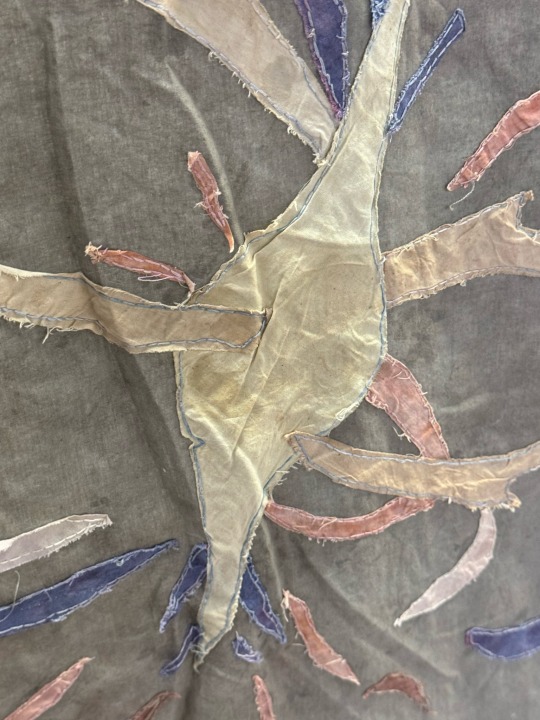
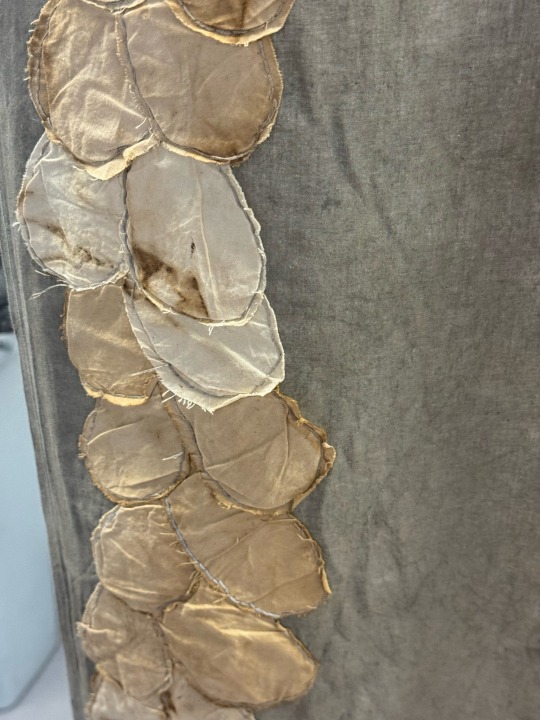
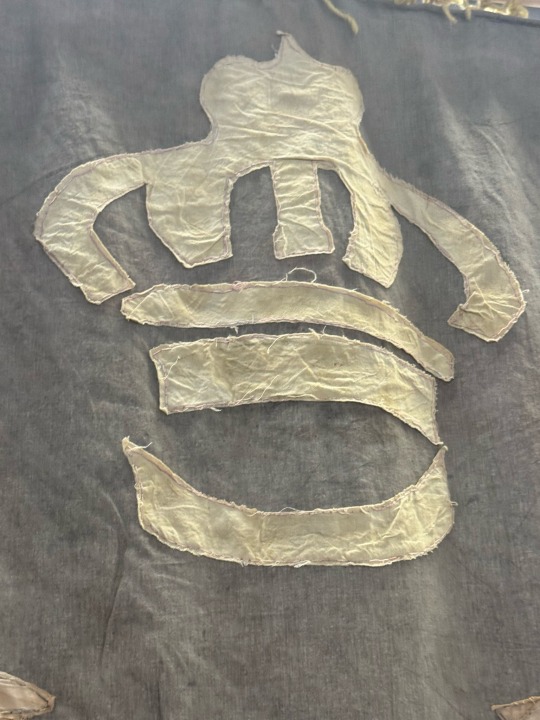
My fiber arts final! This is what I was working on instead of any of my normal illustration. It’s a Torah ark cover— a parochet— and it’s meant to commemorate the Simchat Torah Pogrom. The bit in the middle is a supernova, while the bits at the sides are meant to be either grain or challah, representing the kibbutzim. The Hebrew reads “We will dance again,” in reference to Mia Schem. All naturally dyed. Anyone clowning in the notes will be immediately blocked.
IMAGE ID: A series of photographs of a curtain hung in front of a wall. The curtain has a grey background and a number of appliqué pieces sewn on with embroidery floss. In the center is the image of a supernova and it’s framed by pillars of wheat like brown leaves on each side. On the top is a yellow crown, while on the bottom is the Hebrew: עוד נרקוד שוב. The Hebrew lettering is in pink and is attached with a pale yellow satin stitch. The first photograph is of the entire piece, while the other three are detail shots of the supernova, the wheat, and the crown. END ID.
#my art#sewing#embroidery#appliqué#judaica#parochet#October 7#jumblr#Jewish#simchat torah pogrom#am yisrael chai#fiber arts#natural dye
68 notes
·
View notes
Text
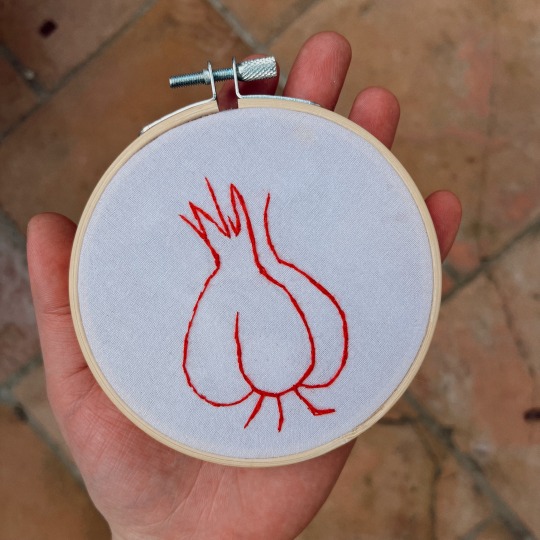
Garlic embroidery hoop
33 notes
·
View notes
Text

#lesbian#gay#bisexual#transgender#lgbtq#actually autistic#autism#adhd#jewish#shitposting#shitpost#crochet#embroidery
17 notes
·
View notes
Text
I got this absolutely GORGEOUS book at the Getty a few weeks ago, and let me tell you, it is absolutely incredible! The illustrations include photographs of stunningly beautiful illuminated manuscripts, which were enough for me to buy it delightedly, but the writing is also really excellent; informative, engaging, with in depth references to a wide variety of things.
I've only read the first chapter and started the second, but there has already been a reference to Where the Wild Things Are by Maurice Sendak, and the delightful discovery that an at first strange-seeming juxtaposition of a sage studying torah and a squirrel eating a nut is not so odd after all. It turns out that cracking a nut was a common medieval metaphor for the study of torah: "hard to crack, but rewardingly nutritious on the inside, the very food of life."
#i'm hoping among other things that I'll find some inspiration for embroidery#jumblr#torah#Jewish Things
24 notes
·
View notes
Text
Currently thinking about crafting (some of) my own judaica one day like.... just imagining being able to craft and then use, like, challot covers that I made for instance??? Wow..........
I one day want to start like... A jewish crafting club or something!!! Like, how cool would that be
#jumblr#jew by choice#jewish conversion#personal thoughts tag#i'm thinking about patterning for a crochet challot cover but... hmmm#i don't do embroidery right now but i do crochet (taking a break but i know it better than anything else)#i just love being able to make something that is *exactly* how you want#i'd also love making mezuzot covers!!!!!! from what i understand the cover can be... pretty much anything. imagine woodcarving one...#i've done wood carving once (not ironic but it's funny because i did it in ..... jesus camp. i only went there for the bread ngl)
24 notes
·
View notes
Text

7 notes
·
View notes
Text
...now I want to make a kippah with "women want me, fish fear me" on it in Hebrew
Tunic embroidered with old Norse runes around the bottom that read “I joined the SCA and all I got was this stupid t-tunic”
#like i wouldn't do a tallis with that because that's an actual sacred item#but tbh if people can wear sports team kippot i can put a shitpost on mine#bonus points if i hear someone behind me in synagogue choke back laughter during the middle of services because they figured it out :D#embroidery#funny#jewish shitposting#shitposting#jumblr#jewish stuff
11K notes
·
View notes
Text
I got a job at a Ukrainian museum.
On the first day someone asks me if I have any Ukrainian heritage. I say I had ancestors from Odesa, but they were Jewish, so they weren’t considered Ukrainian, and they wouldn’t have considered themselves Ukrainian. My job is every day I go through boxes of Ukrainian textiles and I write a physical description, take measurements, take photographs, and upload everything into the database. I look up “Jewish” in the database and there is no result.
Some objects have no context at all, some come with handwritten notes or related documents. I look at thick hand-spun, hand-woven linen heavy with embroidery. Embroidery they say can take a year or more. I think of someone dressed for a wedding in their best clothes they made with their own hands. Some shirts were donated with photographs of the original owners dressed in them, for a dance at the Ukrainian Labour Temple, in 1935. I handle the pieces carefully, looking at how they fit the men in the photos, and how they look almost a hundred years later packed in acid-free tissue. One of the men died a few years later, in the war. He was younger than I am now. The military archive has more photographs of him with his mother, his father, his fiancé. I take care in writing the catalogue entry, breathing in the history, getting tearful.
I imagine people dressed in their best shirts at Easter, going around town in their best shirts burning the houses of Jews, in their best shirts, killing Jews. A shirt with dense embroidery all over the sleeves and chest has a note that says it is from Husiatyn. I look it up and find that it was largely a Jewish town, and Ukrainians lived in the outskirts. There is a fortress synagogue from the Renaissance period, now abandoned.
When my partner Aaron visits I take him to an event at the museum where a man shows his collection of over fifty musical instruments from Ukraine, and he plays each one. Children are seated on the floor at the front. We’re standing in a corner, the room full of Ukrainians, very aware that we look like Jews, but not sure if anyone recognizes what that looks like anymore. Aaron gets emotional over a song played on the bandura.
A note with a dress says it came from the Buchach region. I find a story of Jewish life in Buchach in the early twentieth century, preparing to flee as the Nazis take over. I cry over this.
I’m cataloguing a set of commemorative ribbons that were placed on the grave of a Ukrainian Nationalist leader, Yevhen Konovalets, after he was assassinated. The ribbons were collected and stored by another Nationalist, Andriy Melnyk, who took over leadership after Konovalets’ death. The ribbons are painted or embroidered with messages honouring the dead politician. I start to recognize the word for “leader”, the Cyrillic letters which make up the name of the colonel, the letters “OYH” which stand for Organization of Ukrainian Nationalists (OUN in English). The OUN played a big part in the Lviv pogroms in 1941, I learn. The Wikipedia article has a black and white image of a woman in her underwear, running in terror from a man and a young boy carrying a stick of wood. The woman’s face is dark, her nose may be bleeding. Her underwear is torn, her breast exposed. I’m measuring, photographing, recording the stains and loose threads in the banners that honour men who would have done this to me.
Every day I can’t stop looking at my phone, looking up the news from Gaza, tapping through Instagram stories that show what the news won’t. Half my family won’t talk to the other half, after I share an article by a scholar of Holocaust and genocide studies, who says Israel is committing a genocide. My dad makes a comment that compares Gaza to the Warsaw Ghetto. This gets him in trouble. My aunt says I must have learned this antisemitism at university, but there is no excuse for my dad.
This morning I see images from Israeli attacks in the West Bank, where they are not at war. There are naked bodies on the dusty ground. I’m not sure if they are alive. This is what I think of when I see the image from the Lviv pogrom. If what it means for Jews to be safe from oppression is to become the oppressor, I don’t want safety. I don’t want to speak about Jews as if we are one People, because I have so little in common with those in green uniforms and tanks. I am called a self-hating Jew but I think I am a self-reflecting Jew.
I don’t know how to articulate how it feels to be handling objects which remind me of Jewish traumas I inherited only from history classes and books. Textiles hold evidence of the bodies that made them and used them. I measure the waist of a skirt and notice that it is the same as my waist size. I think of clothing and textiles that were looted from Jewish homes during pogroms. I think of clothing and textiles that were looted from Palestinian homes during the ongoing Nakba. Clothes hold the shape of the body that once dressed in them. Sometimes there are tears, mends, stains. I am rummaging through personal belongings in my nitrile gloves.
I am hands-on learning about the violence caused by Ukrainian Nationalism while more than nine thousand Palestinians have been killed by the State of Israel in three weeks, not to mention all those who have been killed in the last seventy-five years of occupation, in the name of the Jewish Nation, the Jewish People — me? If we (and I am hesitant to say “we”) learned anything from the centuries of being killed, it was how to kill. This should not have been the lesson learned. Zionism wants us to feel constantly like the victims, like we need to defend ourself, like violence is necessary, inevitable. I need community that believes in freedom for all, not just our own People. I need the half of my family who believes in this necessary “self-defence” to remember our history, and not just the one that ends happily ever after with the creation of the State of Israel. Genocide should not be this controversial. We should not be okay with this.
Tomorrow I will go to work and keep cataloguing banners that honour the leader of an organization which led pogroms. I will keep checking the news, crying into my phone, coordinating with organizers about our next actions, grappling with how we can be a tiny part in ending this genocide that the world won’t acknowledge, out of guilt over the ones it ignored long ago.
8K notes
·
View notes
Note
Where do you find references or research to create all the unique patterns in your compositions and the outfits of your characters?
When I do reference, mainly books on Greek/Jewish textiles, architecture and illuminations. Books are expensive though 💀 I'll add some online resources!!
Skies of Parchment, Seas of Ink (link to scanned version)
Ceremonial Synagogue Textiles: From Ashkenazi, Sephardi, and Italian Communities
The Jewish virtual museum has some resources
This folk costume blog is a great resource for Greek regional clothing, but also folk clothing and embroidery in general. I love this blog
I do end up making a lot of patterns based on my own memories of everything I've seen, too though. Hopefully some of those resources will be helpful!
#Hyde replied#sometimes i also reference Japanese fabrics and symbolism as well though. I'm from a mixed culture family#so sometimes that works it's way in to my work too#resources#my work is very much a half and half mix of personal symbolism and specifics so a lot of it isn't direct reference
232 notes
·
View notes
Text
People loved my native judean miku so much i- 🥹 i didn't expect that
THANK YOU ALL SO MUCH🙏🏻🙏🏻🙏🏻
I want to try another verse(i warn you the style will be different bc i don't have a style yet lol)
#israel#jumbler#am israel hai#ישראבלר#jewish#jews#jewish miku#israeli miku#Native miku#miku hatsune#hatsune miku#vocaloid miku#Jewish clothing#Jewish history#Jewish culture#Jewish embroidery#Rikma#ישראל#Ancient israel#Ancient judea#Israeli#Judean#Israelite#from the river to the sea yall can suck my d
29 notes
·
View notes
Text
source

Jewish woman’s wrap (izar) and face veil (khiliyye), Baghdad, Iraq, late 19th century
#jewish history#middle eastern history#dress history#mizrahi jews#mizrahim#judaism#this is so beautiful#the colors and embroidery
718 notes
·
View notes
Text
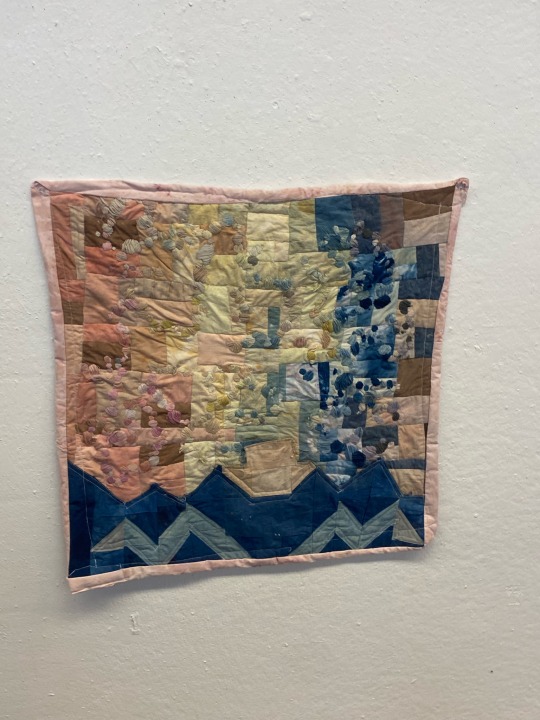
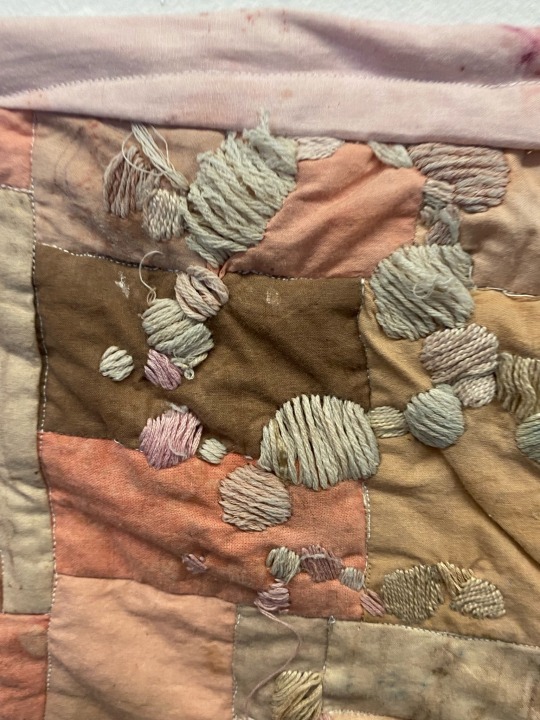
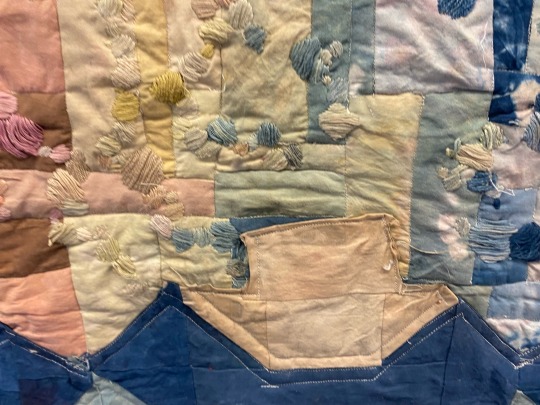
My midterm for my fibers class! All naturally dyed, and the embroidery took forever. The prompt was more or less “do something with color,” so I thought I’d do the story of Noah with the rainbow.
IMAGE ID: Three photos of an art quilt showing a simple geometric boat on triangular waters, I. Front of a rainbow sky. The rainbow is made up of rectangles of different colors underneath circles of satin stitch embroidery in similar but different colors. The first photo shows the entire piece pinned up on the wall. The second one is a close up on the embroidery in the red part of the rainbow, while the third is a close up on the boat and the embroidery around it. END ID.
#my art#quilt#natural dye#embroidery#jewish quilters#Jewish art#Jewish quilts#jumblr#Noah’s ark#Torah#jewish creators#embroidery art#art quilt#handmade quilt#quilt love
66 notes
·
View notes
Text
I frequently mourn the fact that so little is commonly known about the smaller details of traditional Jewish life. And I don't mean diaspora Jewish life, it's amazing how much we know and have preserved of various diaspora community traditions.
I mean ancient Judean lifestyles. And yes, the Torah outlines a lot of it, which is amazing. But I don't want to just know that Judean women wore jewelry or nose rings or etc, I want to be able to know what our traditional Jewish jewelry looked like. Smaller specifics instead of the broad strokes.
We can know what religious garb looked like, and even the general gist of day to day clothing. But I want to know specifically what colors people would dye their clothes for their personal tastes, the specific embroidery designs that were worn.
I want to know how traditional Judean women wore their hair, both how they wore their head coverings (knot styles, accessories for the coverings, etc) and how unmarried women would adorn their heads.
I want to know what traditional Judean makeup looked like, what toys the children played with, so so so many aspects of ancient Jewish life that I have been able to find nothing about.
Maybe, of course, I just don't know enough history. But I've tried googling these things and I have not ever found a satisfactory answer.
I wish to know what traditional, pre-occupation, pre-exile Jewish life was like.
If anyone knows anything about any of this, please please please reblog or send an ask or comment about anything you know.
This topic is of great interest to me but I'm not great at finding good history information, I've got more experience doing in-depth research on current events and politics.
1K notes
·
View notes
Text
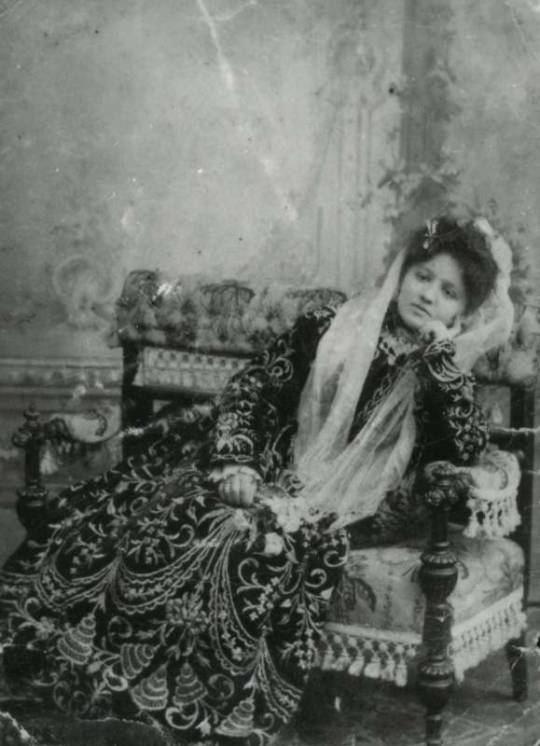
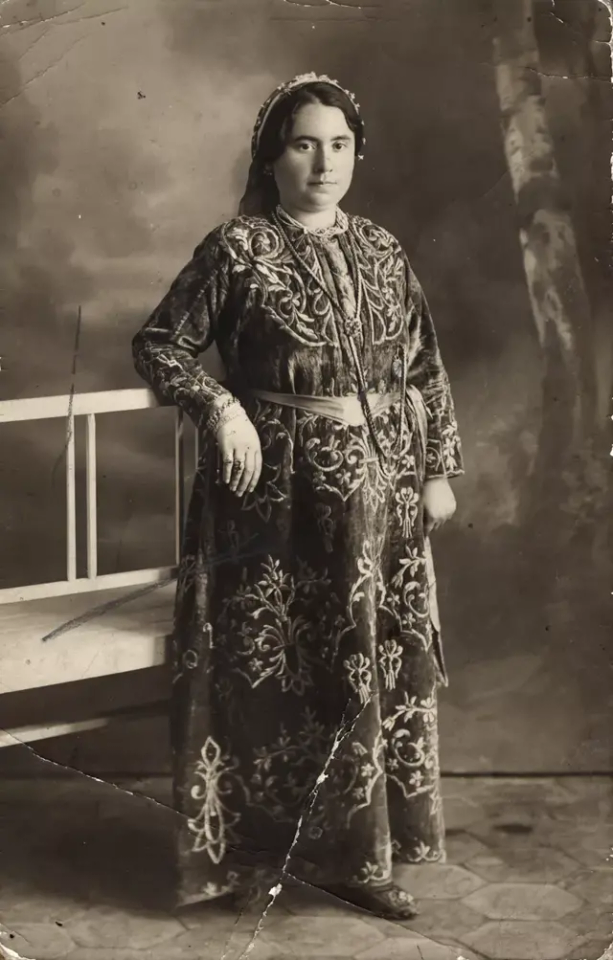
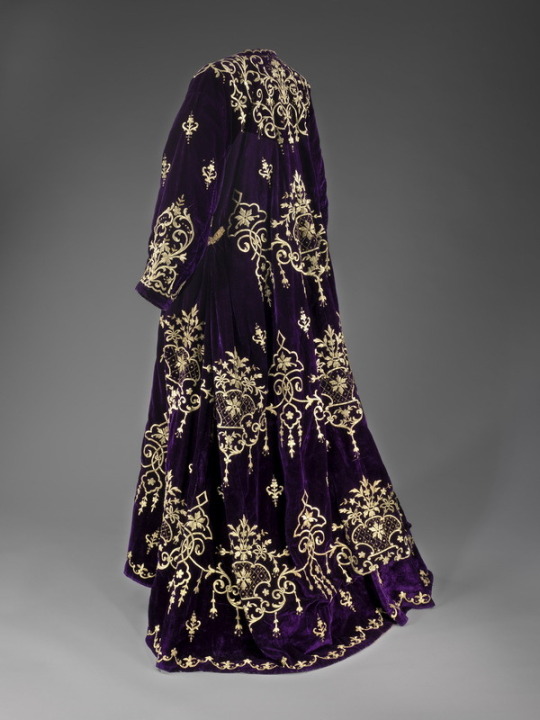

From right to left: Beya Melamed; Bulgaria, 1890 - Jewish bride after the wedding; Turkey, early 20th century - Torah ark curtain made from a woman’s dress; Izmir, Turkey, 1929 - Wedding dress belonging to a Jewish family from Edirne, Turkey; early 20th century, gifted to museum exhibition in memory of Colombe Papo
Worn in the 19th and 20th century for weddings and other occasions by women across the Balkans and Anatolia, bindallı dresses were typically made of velvet in deep jewel tones. They were decorated with extensive gold embroidery of floral designs, which give this group of dresses their name, meaning thousand branches. This Ottoman-derived yet European-influenced style marked a transitional period between uses of traditional and modern western fashions.
The dresses - adopted from the surrounding culture as a fashionable item without any Jewish specificity - took on unique Jewish meaning through their use in the synagogue, where they became ark curtains, Torah mantles and binders, bimah covers, and the like, frequently with added dedicatory inscription. The donation of dresses and trousseau items by women to the synagogues created a personal bond between the women and the synagogue. The habit of donating these textiles to the synagogue endured long after the original embroidered bedclothes and dresses had gone out of fashion, and the transitional bindallı fashion thus remained alive in Sephardi synagogues long after the passing of the brides who wore the dresses.
#jumblr#jewish#jewish history#jewish culture#sephardic history#sephardic culture#this makes me so emotional tbh - the personal bond between the woman and the synagogue; the way they're kept alive through it;#the way we make our surroundings uniquely and specifically jewishly meaningful. no matter where we are or what it is#I unfortunately couldn't find a name for the bride on the top left which is upsetting bc#I think it's important to provide names whenever you can find them with this sort of thing. I've provided all the details I can find#I'd like to do a regular post like this focusing on culture + contributions + connections + etc of jewish women#and sephardic women specifically because we need more of it#my posts
497 notes
·
View notes
Text

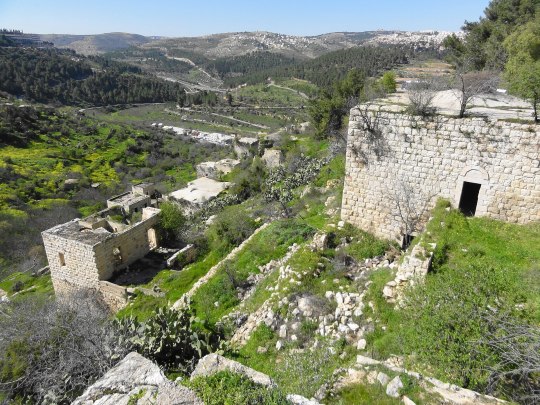
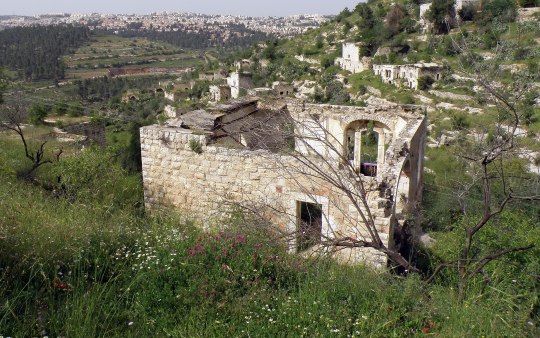

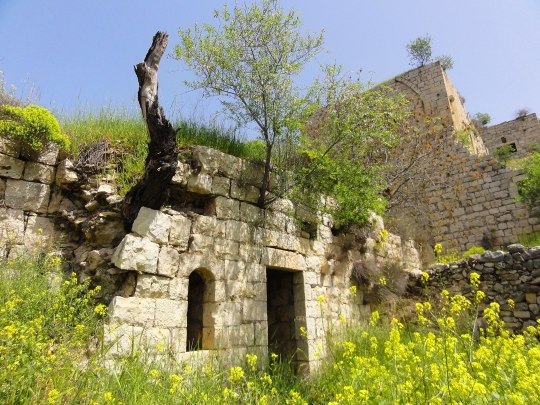
when the homes in the depopulated palestinian village of lifta were originally built is impossible to tell and most likely varies from house to house. the area's been known since ancient times, including having been written about in the hebrew bible. it's retained multiple different names throughout history - lifta by romans, nephto by byzantines, clepsta by crusaders, then lifta again by arabs. in more recent times, the area saw battle in the early 19th century, when it saw a peasant's revolt against egyptian conscription and taxation policies. (egyptian-ottoman ruler muhammad ali had attempted to become independent from the ottoman empire, and sought to use the area of "greater syria" which palestine was apart of as a buffer state.)
the village was predominantly muslim with a mosque, a maqām for local sage shaykh badr, a few shops, a social club, two coffee houses, and an elementary school which opened in 1945. its economy was based in farming - being a village of jerusalem, farmers would sell their produce in the city's markets. an olive press which remains in the village gives evidence to one of the most important crops its residents farmed. the historically wealthy village was known for its intricate embroidery and sewing, particularly of thob ghabani bridal dresses, which attracted buyers from across the levant.
lifta also represents one of the few palestinian villages in which the structures weren't totally or mostly decimated during the 1948 nakba. 60 of the 450 original houses remain intact. from zochrot's entry on lifta:

israel's absentee property law of 1950 permits the state to expropriate land and assets left behind, and denies palestinians the right to return to old homes or to reclaim their property. it's estimated that there's around 400,000 descendants of the village's original refugee population dispersed in east jerusalem, the west bank, jordan, and the palestinian diaspora.
like many depopulated palestinian houses, some of those in lifta were initially used to settle predominantly mizrahi immigrants and refugees, in this case 300 jewish families from yemen and kurdistan. the houses weren't registered in their names, and the area generally saw poor infrastructure and no resources including water and electricity provided by the government. most left in the early 1970s as a part of a compensation program to move out people who'd been settled in depopulated palestinian houses - if they didn't, they were referred to as "squatters" and evicted. (holes were even drilled in the roofs of evacuated buildings to make them less habitable). the 13 families which remain there today only managed to do so because they lived close to the edge of the village.
in 1987, the israeli nature reserves authority planned to restore the "long-abandoned village" and turn it into a natural history center which would "stress the jewish roots of the site", but nothing came of it. several more government proposals on what to do with the land had been brought up since then. this culminated in in 2021 when the israel land administration announced without informing the jerusalem municipal authorities that it issued a tender for the construction of a luxury neighborhood on the village's ruins, consisting of 259 villas, a hotel, and a mall. since 2023, they've agreed to shelve and "rethink" these plans after widespread objection.
the reasons for the objections varied significantly between the opposing israeli politicians - who see the village as an exemplar of cultural heritage and "frozen in time" model of palestinian villages before 1948 - and palestinians - who largely see the village as a witness of the nakba and a symbol of hope for their return. lifta is currently listed by unesco as a potential world heritage site, a designation netanyahu has threatened to remove several times.
many palestinians who are descendent from its former residents still live nearby. like with many other depopulated palestinian villages, they've never ceased to visit, organize tours of the village, and advocate for its preservation.
#palestine#info#nakba#my posts#the dresses link isnt specific to lifta thobs but provides a good overview#i couldn't find anything online abt lifta's embroidery but some of the book pdfs on palestinian costume i reblogged a while ago have info
412 notes
·
View notes